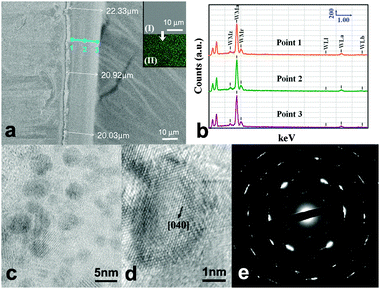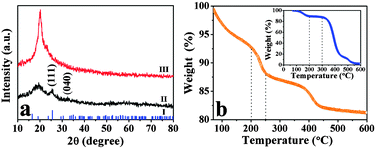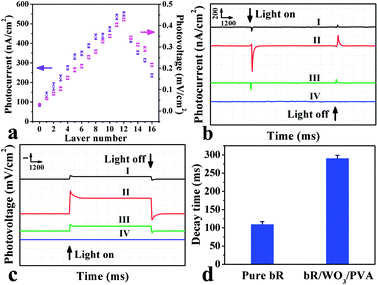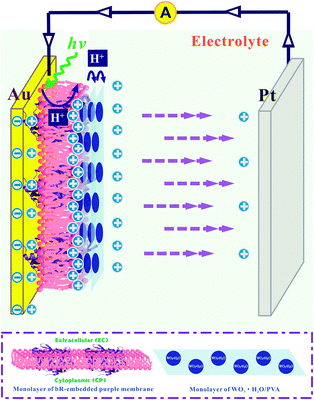Enhancement of photoelectric response of bacteriorhodopsin by multilayered WO3·H2O nanocrystals/PVA membrane
Rui
Li
ab,
Fengping
Hu
ab,
Qiaoliang
Bao
ab,
Shujuan
Bao
ab,
Yan
Qiao
ab,
Shucong
Yu
a,
Jun
Guo
c and
Chang Ming
Li
*ab
aSchool of Chemical and Biomedical Engineering, Nanyang Technological University, 70 Nanyang Drive, Singapore 637457, Singapore. E-mail: ECMLi@ntu.edu.sg; Fax: +65 6791 1761; Tel: +65 6790 4485
bCenter for Advanced Bionanosystems, Nanyang Technological University, 70 Nanyang Drive, Singapore 637457, Singapore
cSchool of Materials Science and Engineering, Nanyang Technological University, Nanyang Avenue, Singapore 639798, Singapore
First published on 23rd December 2009
Abstract
For the first time, a multilayered WO3·H2O/PVA membrane on bacteriorhodopsin (bR) is constructed to significantly enhance the photoelectric response of bR by the spillover effect of WO3·H2O nanocrystals, providing great potential in its important applications in bioelectronics and proton exchange membrane fuel cells.
Bacteriorhodopsin (bR) is the only protein component of the purple membrane (PM), a two-dimensional crystal lattice in Halobacterium salinarum (H. salinarum) and one of the simplest biological energy converters. Due to its extreme stability to various environmental conditions,1 extraordinary photoelectric and photochromic properties and superior ability to maintain biological activity on a solid support,2 bR has become one of the most promising biomaterials for various applications in the bioelectronics field.3 Light absorption by bR leads to conformational change of the protein, thus driving a proton translocation across the membrane from the cytoplasmic side to the outer medium.4 The resulting proton gradient generates the electrochemical photocurrent.5 At this juncture, the enhancement of the photoelectric response of a bR-based system is essential and is the main challenge in its practical applications. Various methods such as chemically induced enhancement6 and layer-by-layer enhancement7 have been reported. Nanomaterials possess unique properties arising from the size reduction and thus are attracting major attention in bioelectronics applications.8 Some nanomaterials have been incorporated with bR to either increase the amplitude9 or change the pattern10 of its photoelectric responses. Application of WO3·H2O nanocrystals in a biomolecule-based system, however, has never been studied to date. Based on their spillover effect, WO3·H2O nanoparticles have been recently employed to improve the performance of the proton exchange membrane in fuel cells.11 Since the photoelectric response of bR originates from the protein's unique proton translocation, it can be expected to be enhanced by the effective proton spillover of WO3·H2O nanocrystals. It remains a great challenge to construct a unique bR/WO3·H2O nanostructure for the enhancement.
In our work, we incorporate WO3·H2O nanocrystals into a PVA matrix to engineer a novel bio-organic–inorganic interface with bR. bR-embedded PM was isolated from Halobacterial halobium S9 strain according to the standard protocol,12 of which a 5 mg ml−1 suspension in DI water was prepared before use. An electrophoretic sedimentation (EPS) method5 was used to uniformly immobilize the bR-embedded PM with a favorable orientation on a gold electrode. 1 g tungsten powder was dissolved in a mixture of 10 ml 30% H2O2 solution, 10 ml DI water and 5 ml isopropanol to prepare a precursor of WO3·nH2O nanocrystals. 2 ml of the as-prepared precursor was then mixed with 6 ml of the 66.67 mg ml−1 PVA (MW = 164![[thin space (1/6-em)]](https://www.rsc.org/images/entities/char_2009.gif) 000) solution (∼18% (w/w) WO3) followed by spin-coating on a freshly prepared bR-modified electrode (the ratio was optimized by preliminary experiments). The thickness of the WO3·nH2O precursor/PVA layer could be tailored by repeating a number of spin-coating operations, followed by one-hour heating at 60 °C to allow formation of the integrated bR/WO3·nH2O/PVA membrane. As controls, WO3·nH2O/PVA membrane and bR/PVA membrane, respectively were also prepared.
000) solution (∼18% (w/w) WO3) followed by spin-coating on a freshly prepared bR-modified electrode (the ratio was optimized by preliminary experiments). The thickness of the WO3·nH2O precursor/PVA layer could be tailored by repeating a number of spin-coating operations, followed by one-hour heating at 60 °C to allow formation of the integrated bR/WO3·nH2O/PVA membrane. As controls, WO3·nH2O/PVA membrane and bR/PVA membrane, respectively were also prepared.
The surface morphology of the as-prepared membrane and the distribution of tungsten element across the membrane were examined by field-effect scanning electron microscopy (FESEM, JEOL JSM-6700F FESEM) and energy dispersive X-ray spectroscopy (JEOL EX-23000BU EDX Thermal Analyzer), respectively. The cross-section image of the WO3·nH2O/PVA membrane (prepared by 12 times of spin-coating) (Fig. 1a) illustrates that the thickness of WO3·nH2O/PVA membrane is quite consistent. Inset I shows that the surface morphology of the WO3·nH2O/PVA membrane is smooth with no obvious protuberance. The EDX mapping of the membrane surface (Inset II) and the EDX spectra (Fig. 1b) corresponding to the measured points shown in the membrane cross-section (Fig. 1a) demonstrate that the tungsten element is uniformly distributed across both directions of the WO3·nH2O/PVA membrane. High resolution transmission electron microscopy (HRTEM, JEM 2100F, 200 kV, JEOL, Japan) was carried out to study the microstructure of WO3·nH2O embedded in PVA membrane, as shown in Fig. 1c–e. Fig. 1c clearly revealed that WO3·nH2O nanocrystals with diameters of 3–5 nm are spatially stacked in PVA membrane. The crystal lattice of WO3·nH2O was further resolved in Fig. 1d, in which the lattice spacing along (040) is determined to be d040 = 0.27 ± 0.01 nm, in excellent agreement with the lattice constant of the standard WO3 hydrate (JCPDS, card No. 20-1806). The selective area electron diffraction (SAED) pattern in Fig. 1e displays discontinuous rings composed of diffraction spots, which further identifies the polycrystalline nature of the nano-composite membrane.
 | ||
| Fig. 1 (a) SEM micrograph of the cross-section, insets show the (I) SEM micrograph and (II) EDX mapping of the surface, (b) EDX spectra of the cross-section and HRTEM image at (c) low magnification and (d) high magnification, (e) SAED pattern of the WO3·nH2O/PVA membrane. | ||
The crystal structure of the WO3·nH2O/PVA membrane was also characterized by X-ray powder diffraction (XRD, Bruker AXS X-ray diffractometer). In Fig. 2a, three relatively sharp peaks are shown in curve II, two of which (2θ = 25.63° and 2θ = 33.44°) can be indexed to the (111) and (040) reflection, respectively, of the tungsten oxide hydrate (I, JCPDS, card No. 20-1806), suggesting that the hydrate of WO3 forms during the preparation of the membrane. Another prominent peak (2θ = 19.42°) can be ascribed to the PVA component, which shifts a little from the main peak (2θ = 20.22°) in the XRD pattern of PVA (curve III) due to the concentration change. No characteristic peaks of impurities are observed. Hence, the prepared membrane is confirmed to be a PVA/WO3 hydrate hybrid. According to the Scherrer Formula,13 the crystallite size of the WO3 hydrate was also calculated to be ∼3.0 nm, which is highly consonant with the previous HRTEM observation.
 | ||
| Fig. 2 (a) XRD patterns of (I) the standard spectrum of tungsten oxide hydrate (JCPDS 20-1806), (II) WO3·nH2O/PVA membrane, and (III) plain PVA membrane; (b) TGA curves of the WO3·nH2O/PVA membrane. Inset shows the TGA curves of the PVA membrane. | ||
The thermal properties of the WO3·nH2O/PVA membrane were determined by thermogravimetric analysis (TGA, Perkin Elmer Pyris Diamond thermogravimetric analyzer). The TGA profile for the WO3·nH2O/PVA membrane in Fig. 2b presents a first weight loss of ∼7% at around 200 °C, which is attributed to the evaporation of the occluded water, followed by a second sharp weight loss of ∼5% at around 250 °C, which should be caused by the loss of chemically combined water in the WO3 hydrate. The TGA curve section of PVA (inset) is rather flat between 200 °C and 300 °C, indicating there is no decomposition of the polymer in the temperature range. Between 250 °C and 440 °C, the third sharp weight loss of ∼6% occurs in the WO3·nH2O/PVA membrane, which is consistent with the obvious weight loss of ∼83% between 320 and 550 °C in the TGA curve of PVA (inset), demonstrating the decomposition of the PVA component in the WO3·nH2O/PVA membrane. From the TGA result, the number of chemically combined water molecules could be calculated to be 1, i.e., the WO3 hydrate should be denoted as WO3·H2O. The abundant water resource in the hydrated WO3 has great significance in maintaining the moisture of the integrated membrane for higher stability11 and a better proton transport environment14 in the integrated membrane.
The photoelectric responses of the integrated bR/WO3·H2O/PVA membrane were measured by Autolab PGSTAT 30 with a Polychrome V system (Till photonics) as the light source (power density = 6.5 mW cm−2).10 Amperometric and potentiometric chrono measurements at open circuit were conducted for the photocurrent and photopotential response, respectively, showing a capacitive nature identical to that generated by pure bR due to the proton pumping effect10 (Fig. 3). Fig. 3a illustrates the effect of multilayer WO3·H2O/PVA on the photoelectric responses of the integrated bR/WO3·H2O/PVA membrane. Both photocurrent and photovoltage response of the membrane proportionally increase with number increase of the coated WO3·H2O/PVA layers on top of the bR layer. However, the photoelectric response hits a maximum at ∼20 μm thickness of the multilayered WO3·H2O/PVA membrane (corresponds to 12 spin-coated single layers), and then drops with further increase of the modified layers. Fig. 3b and c depict the measured typical responding photocurrent and photovoltage profiles for membranes consisting of different components, showing that both photocurrent and photovoltage responses of the integrated bR/WO3·H2O/PVA membrane (signal II in both figures) are enhanced sharply to around six times more than those of pure bR (signal I in both figures). The photoelectric responses for the integrated membrane exhibit significantly longer decay time (Fig. 3d) than that of the pure bR film, suggesting a longer neutralization time of the polarization caused by the larger proton gradient formed by the proton transport in the integrated system.5 However, the PVA/bR membrane without a WO3·H2O component (Fig. 3b and c, signal III) does not generate obvious enhancement of the bR photoelectric response (signal I) in comparison to the integrated bR/WO3·H2O/PVA membrane with the same thickness (signal II). In addition, the WO3·H2O/PVA membrane without bR cannot produce any photoelectric response at all under the same experimental conditions (signal IV in both figures). All these results clearly indicate that WO3·H2O nanocrystal in the integrated bR/WO3·H2O/PVA membrane is the only factor to dramatically boost the photoelectric response of bR.
 | ||
| Fig. 3 Photoelectric responses of the bR/WO3·H2O/PVA membrane. (a) Effect of different layer numbers of WO3·H2O/PVA on the photoelectric responses of integrated bR/WO3·H2O/PVA membrane (n = 4); (b) photocurrent and (c) photovoltage of pure bR (I), bR integrated with 12 layers of WO3·H2O/PVA component (II), bR integrated with 12 layers of PVA component (III) and 12 layers of WO3·H2O/PVA membrane alone (IV); (d) decay time comparison of photocurrents generated by pure bR and integrated bR/WO3·H2O/PVA membrane. | ||
It is very important to understand the fundamental insight of the photoelectric enhancement. It is known that WO3·H2O can perform hydrogen spillover to produce protons,15,16 during which the color of WO3·H2O changes from light yellow to dark yellow showing the hydrogen tungsten bronze formation, which is the direct index of the hydrogen spillover.15 In our work, the color change of the WO3·H2O/PVA membrane in a photoelectric experiment with the bR presence (∼5 h) was much faster than that without bR (∼48 h), possibly evidencing that bR-introduced electric field could strengthen the hydrogen spillover process. A mechanism based on light-driven proton pumping of bR associated with hydrogen spillover of WO3·H2O nanocrystals is therefore proposed, as shown in Fig. 4. When green light irradiates the integrated membrane, protons in the interface between the bR film and the gold electrode are pumped out by bR molecules to produce capacitive current while building a local electric field vertical to the membrane to trick the hydrogen spillover16 of WO3·H2O nanocrystals and produce protons, which should move away from the electrode in the same way as the protons generated from bR. This larger amount of moving protons can definitely build higher potential gradient in the double layer structure of the electrode for a higher photoelectric current. That is why the photoelectric response is proportional to the number of the WO3·H2O/PVA layer in the integrated membrane within a certain range. However, when the WO3·H2O/PVA layer number increases to above 12, the photoelectric response decreases, possibly caused by increased resistance in the thick film (Fig. 3a).
 | ||
| Fig. 4 Model of the photoelectric response generation of the integrated bR/WO3·H2O/PVA membrane. | ||
In brief, construction of a multilayered WO3·H2O/PVA membrane on bR boosts bR's photoelectric response by around six times. The mechanism for the photoelectric enhancement is possibly due to the hydrogen spillover process of the WO3·H2O. This work could provide a method to significantly enhance the bR photoelectric signal in bioelectronic devices and also render a promising proton exchange membrane in bio fuel cell applications.
Notes and references
- A. A. Khodonov, O. V. Demina, L. V. Khitrina, A. D. Kaulen, P. Silfsten, S. Parkkinen, J. Parkkinen and T. Jaaskelainen, Sens. Actuators, B, 1997, 39, 218 CrossRef.
- T. Miyasaka, K. Koyama and I. Itoh, Science, 1992, 255, 342 CrossRef CAS.
- R. R. Birge, Annu. Rev. Phys. Chem., 1990, 41, 683 CrossRef CAS.
- J. K. Lanyi, J. Phys. Chem. B, 2000, 104, 11441 CrossRef CAS.
- (a) B. Robertson and E. P. Lukashev, Biophys. J., 1995, 68, 1507; (b) J. P. Wang, S. K. Yoo, L. Song and M. A. El-Sayed, J. Phys. Chem. B, 1997, 101, 3420 CrossRef CAS; (c) J. P. Wang, L. Song, S. K. Yoo and M. A. El-Sayed, J. Phys. Chem. B, 1997, 101, 10599 CrossRef CAS.
- Y. D. Jin, N. Friedman, D. Cahen and M. Sheves, Chem. Commun., 2006, 1310 RSC.
- R. Li, X. Q. Cui, W. H. Hu, Z. S. Lu and C. M. Li, J. Colloid Interface Sci., 2009 DOI:10.1016/j.jcis.2009.12.013 , in press.
- (a) S. J. Bao, C. M. Li, J. F. Zang, X. Q. Cui, Y. Qiao and J. Guo, Adv. Funct. Mater., 2008, 18, 591 CrossRef CAS; (b) Y. Qiao, C. M. Li, S. J. Bao, Z. S. Lu and Y. H. Hong, Chem. Commun., 2008, 1290 RSC.
- K. M. Bromley, A. J. Patil, A. M. Seddon, P. Booth and S. Mann, Adv. Mater., 2007, 19, 2433 CrossRef CAS.
- R. Li, C. M. Li, H. F. Bao, Q. L. Bao and V. S. Lee, Appl. Phys. Lett., 2007, 91, 223901 CrossRef.
- J. Y. Yang, Y. L. Li, Y. Q. Huang, J. Y. Liang and P. K. Shen, J. Power Sources, 2008, 177, 56 CrossRef CAS.
- D. Oesterhelt and W. Stoeckenius, Methods in Enzymology, Academic Press, San Diego, CA, 1974, vol. 31 Search PubMed.
- H. Klug and L. Alexander, X-ray Diffraction Procedure, Wiley, New York, 1962, p. 125 Search PubMed.
- Y. M. Li, M. Hibino, M. Miyayania and T. Kudo, Solid State Ionics, 2000, 134, 271 CrossRef CAS.
- P. A. Sermon and G. C. Bond, J. Chem. Soc., Faraday Trans. 1, 1976, 72, 730 RSC.
- W. C. Conner and J. L. Falconer, Chem. Rev., 1995, 95, 759 CrossRef CAS.
| This journal is © The Royal Society of Chemistry 2010 |
